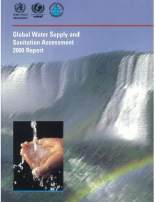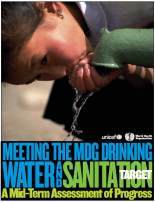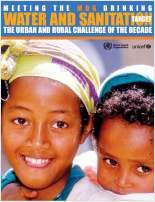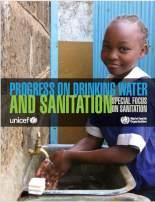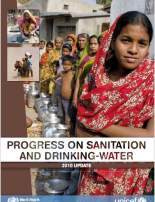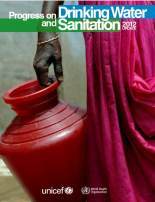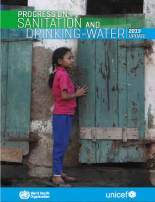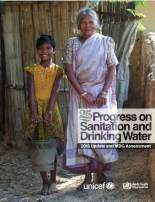Climate resilient WASH
Climate resilient WASH JMP/GLAAS review of indicators for global monitoring of climate resilient WASH Climate-related hazards, shocks and stresses present a growing threat to drinking water, sanitation and hygiene (WASH) services. In response, WHO and UNICEF have launched a review to identify indicators for enhanced national and…Menstrual Health in Schools
Menstrual Health in Schools Universal access to basic water, sanitation, and hygiene (WASH) services is not sufficient for creating a supportive environment for students who menstruate. There are additional elements of menstrual health that need to be considered and monitored. Defining Menstrual Health…Menstrual Health in Schools
Menstrual Health in Schools Universal access to basic water, sanitation, and hygiene (WASH) services is not sufficient for creating a supportive environment for students who menstruate. There are additional elements of menstrual health that need to be considered and monitored. Schoolgirls show homemade…Regional analysis 2024 schools update
Regional analysis 2024 schools update The JMP produces periodic snapshots to summarize the status of water, sanitation, and hygiene for a given region or group of countries. The snapshots are designed to provide a range of signature JMP charts in a format that is easy to customize and to incorporate into presentations and…Regional analysis 2024 health care facilities
Regional analysis 2024 health care facilities The JMP produces periodic snapshots to summarize the status of water, sanitation, and hygiene for a given region or group of countries. The snapshots are designed to provide a range of signature JMP charts in a format that is easy to customize and to incorporate into…Post-2015 consultations
Post-2015 consultationsFacility types
Facility types The JMP has established a standard set of drinking water and sanitation categories that are used for monitoring JMP facility type classification used for SDG monitoring…Core questions
Core questions Through expert consultations, the JMP has developed core questions for monitoring water, sanitation and hygiene at home, schools and health centres To support the collection of comparable data between and within countries, the JMP has prepared core and expanded questions for the following settings: Core…Service ladders
Service laddersData sources
Data sources Nationally representative surveys and administrative data are used to estimate progress on household water, sanitation and hygiene The 2021 JMP update drew on a total of 6,743 data sources, 4,426 of which were used to produce estimates. Similar numbers of datasets were used for drinking water services (n=3,283)…JMP team
JMP team The JMP Team The JMP team consists of five full time professional staff and two part time administrative assistants. The JMP also employs short term consultants for specific tasks. The JMP is overseen jointly by the Coordinator of the Water, Sanitation, Hygiene and Health unit at WHO, the Chief of the Data and…JMP donors
JMP donors The WHO/UNICEF JMP has an annual budget of $3-4 million and is extremely grateful for the financial support it receives from external donors and from within WHO and UNICEF. During 2023 the JMP received a total of US$2.9 million, compared with $1.7 million in 2022. By the end of 2023 development partners had…Wealth quintiles
Wealth quintiles In many countries, pronounced inequalities in water, sanitation and hygiene services persist between rich and poor Inequalities between rich and poor are found in all countries. In those countries where data from national surveys allow for classification of households into asset-based wealth quintiles, it is…Sub-national regions
Sub-national regions Large disparities in water, sanitation and hygiene are found between sub-national regions Disaggregated data reveal significant inequalities between sub-national regions…Affordability
Affordability Affordability of drinking water, sanitation and hygiene UNICEF/WHO report on Measurement and Monitoring Affordability of WASH services The human rights to water and…Estimation methods
Estimation methods The JMP was established in 1990 and has continuously refined the methods used for global monitoring. The JMP document Methodology: 2017 update and SDG baselines provides a detailed technical explanation of the methods and rules applied in the last report, which supersede the methods…Methods
Methods The JMP uses a standard classification and estimation method to compare progress across countries, regions and the world. Download country files and create custom graphs for households, schools or health care facilities from the JMP data portal. Improved pit latrine in Guinea-Bissau (c)…Country and regional engagement
Country and regional engagement WHO and UNICEF are active in over 190 countries worldwide and the JMP has well-established mechanisms for collecting and compiling data from national sources and consulting with national authorities on estimates. JMP country files and regional summary files, covering WASH in…JMP strategy
JMP strategy WHO/UNICEF JMP Strategy 2021-2025 Vision: progressive realization of universal access to drinking water, sanitation and hygiene (WASH) and the reduction of inequalities in service levels by 2030 Mission: to produce reliable estimates of national, regional and global progress on WASH to inform decision making by…
